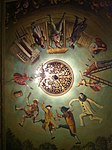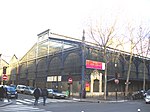Boulevard du Temple
11th arrondissement of Paris3rd arrondissement of ParisBoulevards in Paris

The Boulevard du Temple, formerly nicknamed the "Boulevard du Crime", is a thoroughfare in Paris that separates the 3rd arrondissement from the 11th. It runs from the Place de la République to the Place Pasdeloup, and its name refers to the nearby Knights Templars' Temple where they established their Paris priory.
Excerpt from the Wikipedia article Boulevard du Temple (License: CC BY-SA 3.0, Authors, Images).Boulevard du Temple
Boulevard du Temple, Paris 3rd Arrondissement (Paris)
Geographical coordinates (GPS) Address Nearby Places Show on map
Geographical coordinates (GPS)
| Latitude | Longitude |
|---|---|
| N 48.863288888889 ° | E 2.3665083333333 ° |
Address
Boulevard des Filles du Calvaire (Musée Picasso)
Boulevard du Temple
75003 Paris, 3rd Arrondissement (Paris)
Ile-de-France, France
Open on Google Maps










